Shenandoah National Park
Groundwater Residence Times in Shenandoah National Park, Blue
Ridge Mountains, Virginia, USA: A Multi-Tracer Approach
L.N. Plummer, E. Busenberg, J.K. Böhlke, D.L. Nelms, R.L. Michel, and P. Schlosser
In This Document
Abstract
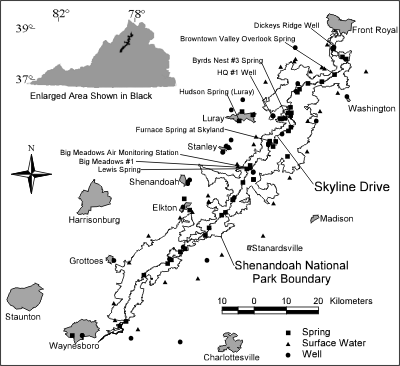
Location of springs and wells sampled in Shenandoah National Park.
Chemical and isotopic properties of water discharging from springs and wells in Shenandoah National Park (SNP), near the crest of the Blue Ridge Mountains, Virginia, USA were monitored to obtain information on groundwater residence times. Investigated time scales included seasonal (wet season, April, 1996; dry season, August-September, 1997), monthly (March, 1999 through September, 1999) and hourly (30-minute interval recording of specific conductance and temperature, March, 1999 through February, 2000). Multiple environmental tracers, including tritium/helium-3 (3H/3He), chlorofluorocarbons (CFCs), sulfur hexafluoride (SF6), sulfur-35 (35S), and stable isotopes (δ18O and δ2H) of water, were used to estimate the residence times of shallow groundwater discharging from thirty-five springs and fifteen wells. The most reliable ages of water from springs appear to be based on SF6 and 3H/3He, with most ages in the range of 0 to 3 years. This range is consistent with apparent ages estimated from concentrations of CFCs, however, CFC-based ages have large uncertainties owing to the post-1995 leveling off of the CFC atmospheric growth curves. Somewhat higher apparent ages are indicated by 35S (>1.5 years) and seasonal variation of δ18O (mean residence time of 5 years) for spring discharge. The higher ages indicated by the 35S and δ18O data reflect travel times through the unsaturated zone and, in the case of 35S possible sorption and exchange of S with soils or biomass. In springs sampled in April, 1996, apparent ages derived from the 3H/3He data (median age of 0.2 years) are lower than those obtained from SF6 (median age of 4.3 years), and in contrast to median ages from 3H/3He (0.3 years) and SF6 (0.7 years) obtained during the late summer dry season of 1997. Monthly samples from1999 at four springs in SNP had SF6 apparent ages of only 1.2 to 2.5 ± 0.8 years, and were consistent with the 1997 SF6 data. Water from springs has low excess air (0-1 cm3kg-1) and N2-Ar temperatures that vary seasonally. Concentrations of He and Ne in excess of solubility equilibrium indicate that the dissolved gases are not fractionated. The seasonal variations in N2-Ar temperatures suggest shallow, seasonal recharge, and the excess He and Ne data suggest waters mostly confined to gas exchange in the shallow, mountain-slope, water-table spring systems. Water from wells in the fractured rock contains up to 8 cm3kg-1 of excess air with ages in the range of 0 to 25 years. Transient responses in specific conductance and temperature were observed in spring discharge within several hours of large precipitation events in September, 1999; both parameters increased initially, then decreased to values below pre-storm base-flow values. The groundwater residence times indicate that flushing rates of mobile atmospheric constituents through groundwater to streams draining the higher elevations in SNP average less than 3 years in base-flow conditions.
Graphs
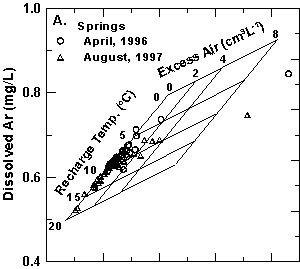
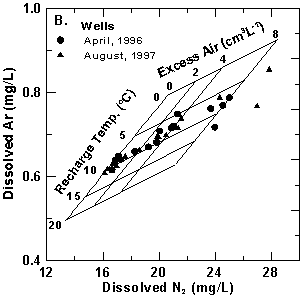
Comparison of concentrations of dissolved N2 and Ar in water from springs (A) and wells (B), in relation to solubility equilibrium and excess air. The calculations assume an average elevation for the samples within SNP of 914m.
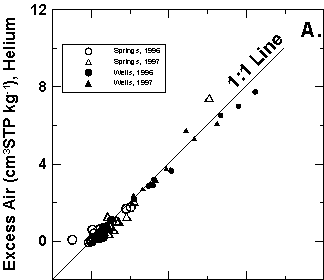
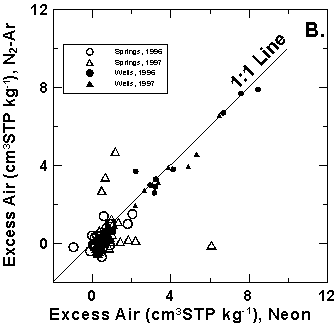
Comparison of excess air (April, 1996 and August-September, 1997 data) in spring and well discharge. (A.) Calculated from dissolved Ne and He data, and (B) calculated from dissolved N2-Ar data, and dissolved Ne data.
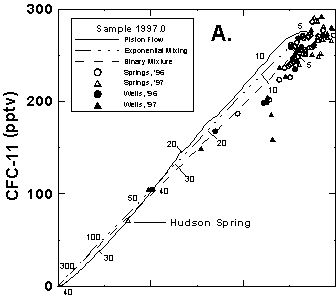
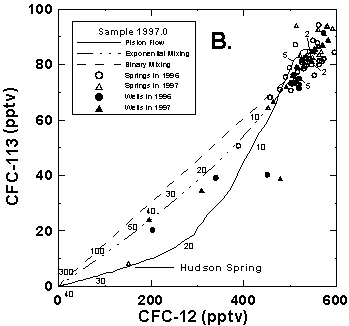
Comparison of the mixing ratios of CFC-11 and CFC-12 (A.), and CFC-113 and CFC-12 (B.) for water from all springs and wells sampled in April, 1996 and August-September, 1997. The data are compared to 3 hypothetical mixing models. The dashed lines correspond to binary mixing of modern (1997) water with old (pre-CFC) water. The long-short dashed lines correspond to exponential mixing in discharge from groundwater reservoirs with mean residence times of 0 to more than 100 years. The solid lines correspond to recharge of water in equilibrium with air (piston flow) for ages (in years from 1997) of 0 to more than 30 years. Numbers referenced to the model lines are travel times (piston flow), or mean residence times (exponential mixing). The models are insensitive to variations in excess air content of 0 to 2 cm3 kg-1, and were calculated without excess air.
Photos
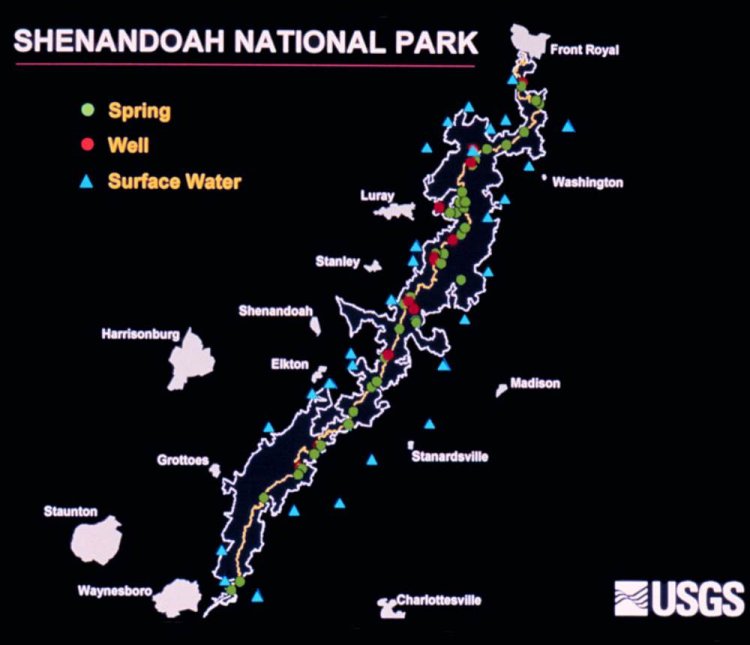
Location of sampling sites in Shenandoah National Park
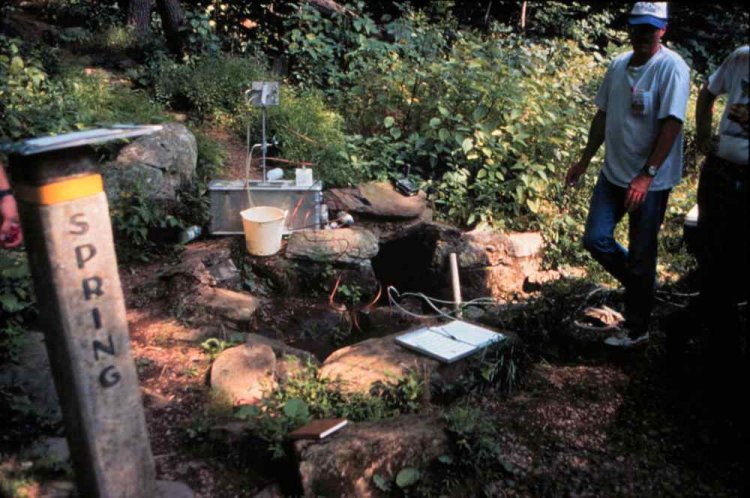
Sampling Indian Run Shelter spring in Shenandoah National Park for CFCs, 3H/3He, and SF6
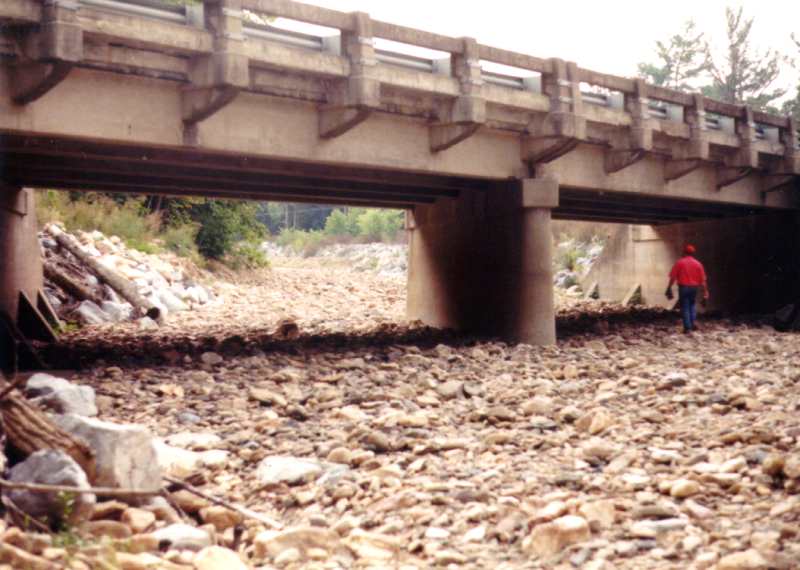
View looking "upstream" of Big Run at U.S. 340 on southwest side of Shenandoah National Park following an extended period of drought, 9/8/97
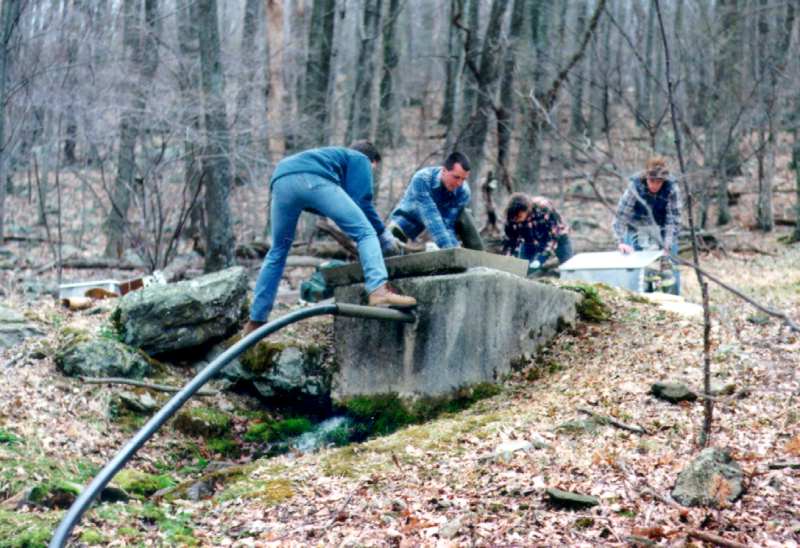
Sampling Byrd's Nest #4 spring, April 12, 1996
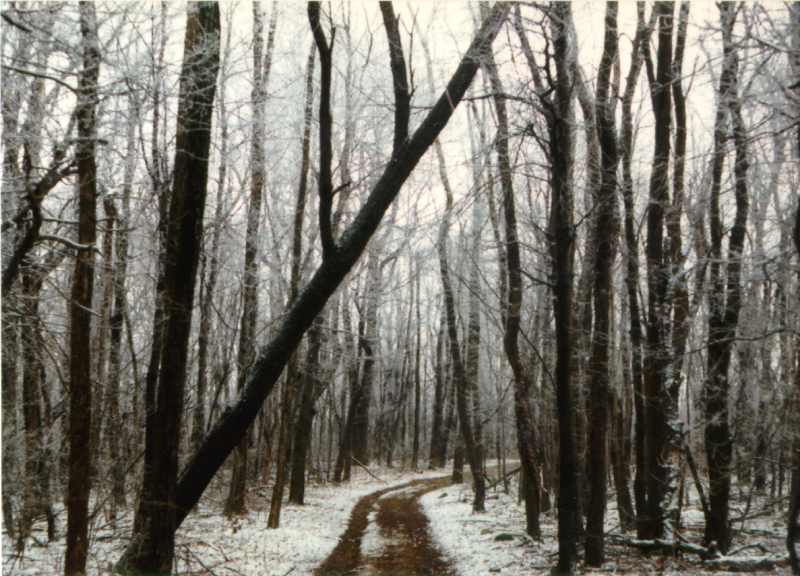
Road to Indian Run Shelter spring, April 9, 1996
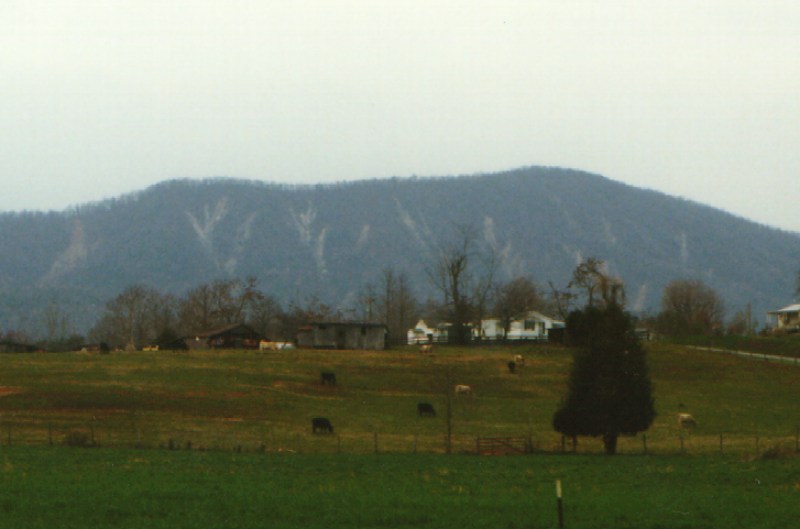
Scars from landslides and debris flows, Blue Ridge Mountains, Madison County, Virginia. More that 1000 debris flows occurred during an intense storm that stalled over the Blue Ridge Mountains and produced over 30 inches of rain in 16 hours, June 27, 1995
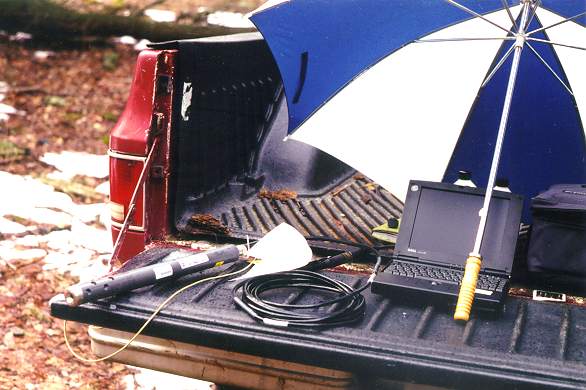
Uploading water quality data from data logger
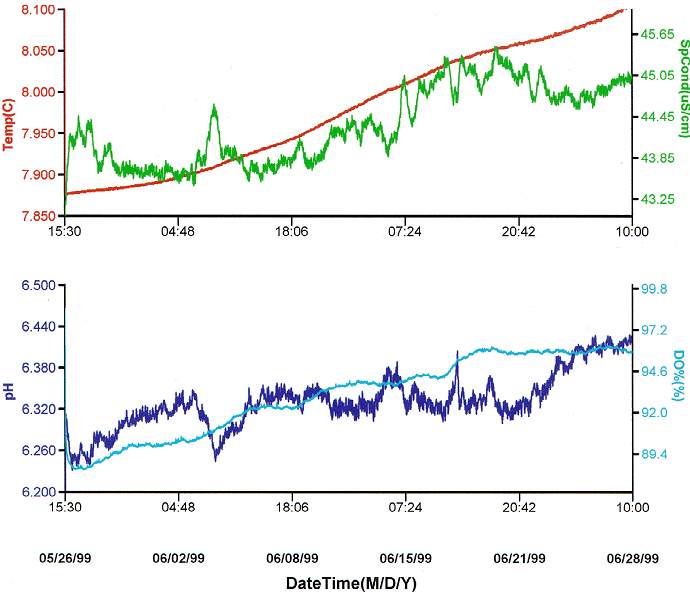
Variations in water temperature, specific conductance, pH and percent saturation of dissolved oxygen in discharge from Furnace Spring, at Skyland, Shenandoah National Park, 5/26/99 - 6/28/99
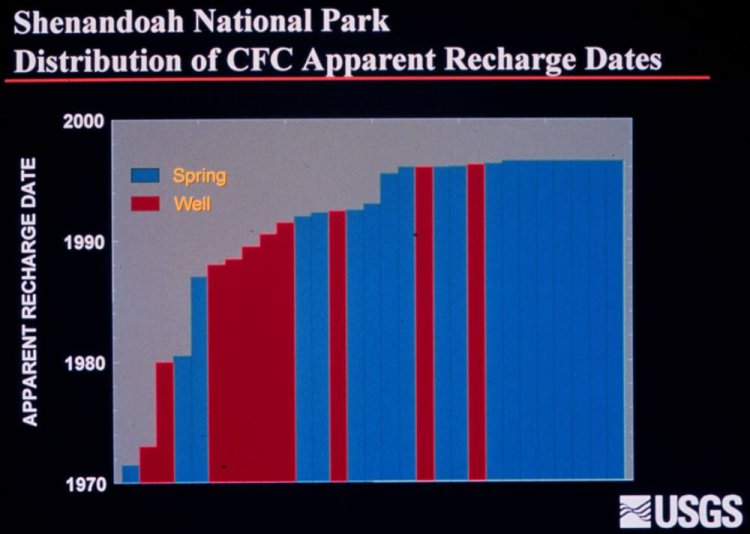
Distribution of apparent CFC-based ages of discharge from wells and springs in Shenandoah National Park
Investigators
L. Niel Plummer, Eurybiades Busenberg, and J.K. Böhlke (U.S. Geological Survey, 432 National Center, Reston, VA 20192), David L. Nelms (U.S. Geological Survey, 1730 East Parham Rd., Richmond, VA 23228).
Publications
Plummer, L.Niel, Busenberg, Eurybiades, Böhlke, John-Karl, Carmody, Rebecca W., Casile, Gerolamo C., Coplen, Tyler B, Doughten, Michael W., Hannon, Janet E., Kirkland, Wandee, Michel, Robert L., Nelms, David L., Norton, Brian C., Plummer, Kathryn E. Qi, Haiping, Revesz, Kinga, Schlosser, Peter, Spitzer, Shane, Wayland, Julian E. and Widman, Peggy K., 2000, Chemical and isotopic composition of water from springs, wells, and streams in parts of Shenandoah National Park, Virginia, and vicinity, 1995-1999. U.S. Geological Survey Open-File Report 00-373, 70p.
Plummer, L.N., Busenberg, E., Bohlke, J.K., Nelms, D.L., Michel, R.L., and Schlosser, P., 2001, Groundwater residence times in Shenandoah National Park, Blue Ridge Mountains, Virginia, USA: A multi-tracer approach. Chemical Geology, v. 179/1-4, p.93-111.